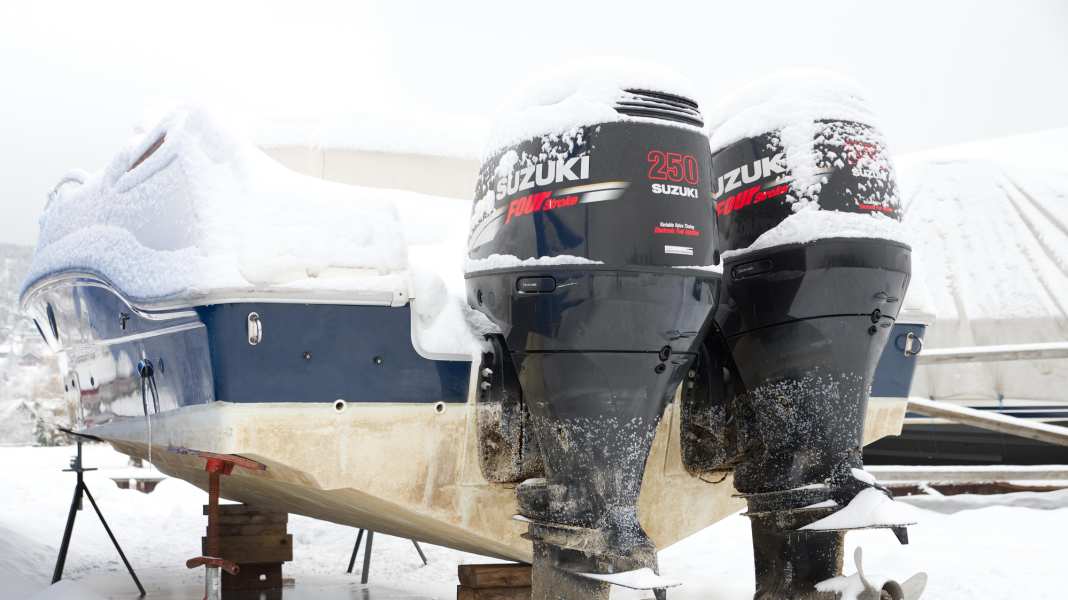
In our latitudes, snow, ice and frosty temperatures are just as characteristic of the dark season as boats waiting in winter storage for the next season to start. Even for professional companies, adverse conditions can mean that certain work cannot be carried out. We spoke to three experts.
Henning Mittelmann, Managing Director of the shipyard of the same name, says that they can work in their halls more or less regardless of the weather. Among other things, Mittelmann has two large halls with "proper underfloor heating". The work in the uninsulated halls was carried out by Mittelmann directly in autumn after the ships were uncraned or in spring before they were uncraned. "In the past, before we had the heated halls, temperatures were a huge issue," says the operations manager, "back then we had to dedicate ourselves to the work inside the ships when temperatures were in the single digits and it was freezing. The other tasks had to be postponed". Nowadays, they would also move ships with modern hydraulic transport equipment into the 800 square metre workshop hall for larger repair jobs.
Myth: Clear coat in extreme cold?
Mittelmann advises owners to follow the manufacturer's instructions when using the various products. "I actually believe that many of the products used today are no longer as forgiving as they used to be. When I was doing my apprenticeship back then, we used to put cans of paint and varnish in a warm water bath and say 'that'll work' and painted anyway," says the entrepreneur from Kappeln an der Schlei.
Mittelmann also dispels the myth that it is advisable to apply clearcoat in extremely cold weather: "Users used to like to talk themselves into this and justify the actually unprofessional use by saying that the result would be better if the paint was applied in frosty temperatures." Time pressure often played a major role in this. "However, the manufacturers have good arguments for the temperature range specified in the data sheets: If you want to achieve a decent result, you have to adhere to the specifications."
Winter storage: experts advise these tasks in cold weather
"The problem with applying resins at too low a temperature is that it takes so long to cure. It depends very much on the resin system, but if the temperature falls below ten degrees, the quality of the resin will definitely be severely impaired or it won't cure at all," says Leif Reincke from Bottsand Bootsbau. The quality of the curing is worse in any case because the chemical bond does not hold as well as if the resin had been processed at higher temperatures. "With antifouling, varnish and paint, the dew point is particularly problematic," reports the managing director of the Wendtdorf shipyard, "if it falls below this point, moisture forms on the surface and the material hardly adheres at all".
Nevertheless, he strongly advises against working with paints and resins even in frosty temperatures. Reincke has a few ideas that owners can carry out in winter storage despite the cold:
- Inspection of the running rigging: Do lines need to be replaced?
- Dismantle, clean and grease winches
- Possible update of the navigation software
- Dismantling the propeller, removing the pocks, sanding and polishing and, if necessary, Trilux coating
- Install new Sail Drive anode
At Yacht Service Kiel, Frank Sothmann and his team do not currently have any heated halls at their disposal. "If we have to do something temperature-controlled in winter, we tent the boats," says Sothmann. Although there is no frost in the unheated hall at the moment, the temperatures there are still only around five degrees.
This work goes even better at low temperatures
"At five degrees and below, you can no longer polish or wax properly. Then you just have to see what else you can do," explains the Managing Director of Yacht Service Kiel. "Nevertheless, at low temperatures it is easier to prepare and scrape off the underwater hull before applying the antifouling paint, for example. This works even better because all the epoxy and the paint are nice and brittle and therefore come off better than at plus 20 degrees," says Sothmann. Otherwise, they would follow the manufacturer's instructions and stick to the temperature range during application.
Sothmann also believes that the risk of catching a cold in winter is considerable: "The problem is that if I put on thick clothes and work a little faster, I start sweating straight away." To prevent this risk, they sometimes close for three to five days in winter, especially if the temperatures in the hall are too low to work productively. Otherwise, they would dismantle individual smaller construction sites on the ships and bring them into their temperature-controlled engine workshop, for example, to solve the problem.

